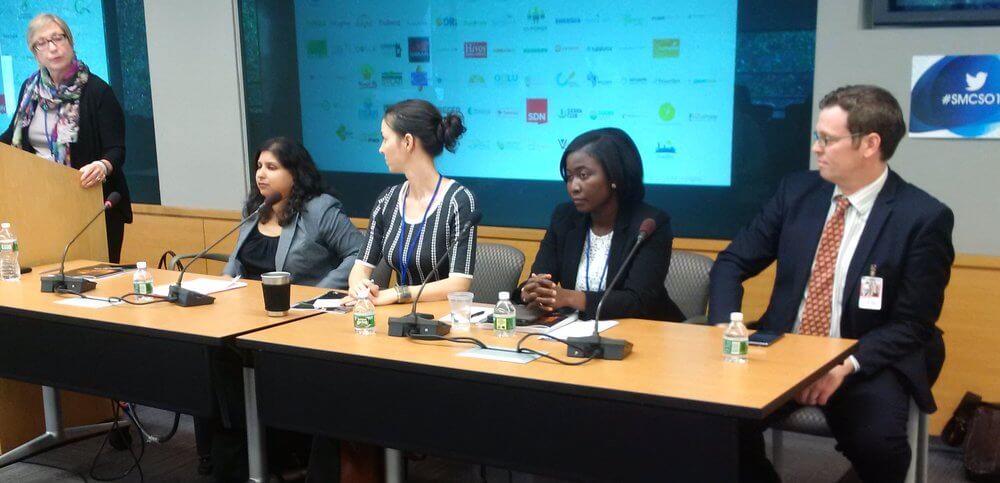Our global goal of extending access to modern energy services to all people by 2030 will remain a distant reality unless there is a fundamental shift in how we implement plans to expand access.
At the recent World Bank’s Civil Society Policy Forum in Washington D.C., Power for All and Practical Action convened a session to exchange ideas on what is needed to make universal access to modern energy a reality in the shortest possible time. The event, From Promise to Progress: Decentralized Renewables and the End of Energy Poverty, included perspectives from Power for All, Practical Action, the World Bank, World Resources Institute and EarthSpark International.
So, what do we need to do differently? The discussion yielded ideas for five pressure points where collective action from government, the private sector and civil society can drive real change.

The From Promise to Progress: Decentralized Renewables and the End of Energy Poverty panel at the World Bank's Civil Society Policy Forum. From L to R: Christine Eibs Singer (Power for All), Sudeshna Ghosh Banerjee (World Bank), Allison Archambault (EarthSpark), Lily Odarno (WRI) and Glen Burnett (Practical Action)
1. All supply options matter
For decades, planners and policymakers viewed the conventional grid as the most appropriate option to extend modern energy sources to communities without access. However, persistent gaps in energy access have raised questions about how much a grid-centric approach can deliver. Today, advancements in technology are driving down the costs of decentralized renewable technologies such as solar. The time is ripe to consider these new supply options. Distributed renewable energy from stand-alone systems, mini- and micro-grids can all play a complementary role in closing the access gap and can bring power faster to remote communities who would, in some cases, wait years to get a grid connection.
2. An effective policy and regulatory environment helps
To support decentralized options, governments must create the right policy and regulatory environment. Existing electrification policies disproportionately favor grid extension and create little opportunity for decentralized solutions to thrive. As a result, communities that might have benefited from solar home systems or micro-grids are left in the dark for years, waiting for the grid to arrive. Both the World Bank’s Regulatory Indicators for Sustainable Energy (RISE) and recent analysis from Power for All indicate that the countries with the greatest access gaps are those that have failed to create effective policy and regulatory frameworks to support the deployment of sustainable energy options such as decentralized renewables.
3. Focus on people
Planning for energy access must begin with the needs of people. Energy is meaningless to people unless it can be used to meet livelihood and other needs. Effective electrification plans use data, analysis and effective consumer engagement to build a profile of what consumers’ needs are and how the variety of supply options can meet demand in an affordable and timely fashion. Practical Action’s 2016 Poor People’s Energy Outlook and a recent publication from World Resources Institute describehow a people-centered, bottom-up planning approach can provide solutions that respond to the varied needs of different consumers.
4. Prove what is possible
To build support for decentralized energy options, policymakers, planners and entrepreneurs must gather evidence to show how these options can deliver. Since mini- and micro-grids are new to most countries as a legitimate electrification source, we need to explore innovative organizational and business models that can deliver results to make a case for what is possible.
A healthy policy and regulatory environment can help scale the sector, but a restrictive policy and regulatory environment can stifle innovation and progress, especially in the very early stages of development. In Haiti, a country without a national electrification policy, EarthSpark International built six micro-grids and experimented with several organizational models (non-profit, for profit, co-op) and business models to prove that micro-grids work.

Lily Odarno, WRI
Based on EarthSpark’s initiatives, Haiti’s government is showing interest in making progress on electrification. EarthSpark is now working with stakeholders at various levels— local, national and international— as well as customers and grid developers to build a conducive policy environment that supports scale and investment in the micro-grid sector.
5. Build partnerships and cross-sectoral linkages
To close the access gap all hands must be on deck. As distributed options play an increasing role in expanding access to energy, we will see growing participation from the private sector and civil society. Coordination among actors — government, civil society, investors and entrepreneurs— can accelerate the impact of efforts to close the access gap.
Likewise, to build sustained demand for energy services, governments must purposefully connect energy planning with development plans for sectors like health, education and agriculture. Governments that work to build partnerships across sectors for energy planning, ensure that the resulting initiatives expand energy to provide productive uses and services to communities that need them.
